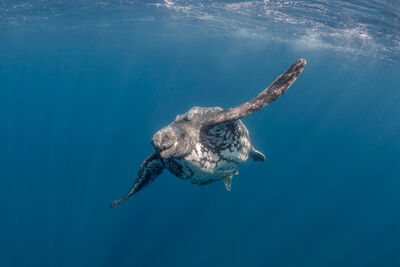Leatherback turtles are massive, ancient sea creatures known for their distinctive shell. In our top ten facts about leatherback turtles, we'll delve into the secrets of their leathery shell, the astounding distances they travel during their global migrations and their surprising preference for a jellyfish-heavy diet. Curious to learn more? Read on to discover what's truly hiding beneath their shells…

Size and weight
Leatherbacks are, without a doubt, the giants of the sea turtle world. They are enormous, growing up to 8ft in length and weighing anywhere from 600 to 1,500lbs - about the same weight as a male polar bear - with some particularly hefty leatherbacks even tipping the scales at over 2,000lbs.

Wide distribution
Leatherbacks are the true globetrotters of the turtle world. These ocean adventurers can be found in nearly every ocean, as far north as the chilly waters near Alaska and as far south as the warm coasts of New Zealand. Their incredible migratory range spans the Atlantic, Pacific and Indian Oceans, often covering thousands of miles in a single journey.

Extraordinary shell
Leatherback turtles have soft shells, unlike other sea turtles which have hard shells. Its leathery shell, also called a carapace, is a teardrop shape - which makes it more streamlined when gliding through the water - and black in colour with pale spots adorning it. The carapace is covered in a rubbery, oily texture with seven distinct ridges running down the length of the shell.

Jellyfish specialists
If leatherbacks had a favourite restaurant, it would be called 'The Jellyfish Buffet.' These turtles are jellyfish connoisseurs, often devouring twice their body weight in jellyfish daily. Although jellies are their first choice, leatherbacks occasionally snack on other soft-bodied creatures such as fish and squid. Unfortunately, their love for gelatinous prey sometimes makes them mistake plastic bags for a tasty meal.

Adaptability
Leatherbacks have some neat adaptations. A thick layer of insulating fat, coupled with their immense size, help leatherbacks regulate their body temperature, allowing them to venture into colder regions than most other sea turtles. The softness of their shells gives them more flexibility and is vital for their deep dives, but it also makes them more vulnerable to injuries and predators than other sea turtles.

Deep divers
Another interesting fact that makes leatherback turtles stand out from the crowd is that they can dive deeper than any other turtle species, reaching depths of over 1,200m in search of jellyfish. They can reach these extraordinary depths due to the ability of their shell to compress under pressure and they also absorb nitrogen through it, which helps prevent decompression sickness, paired with their ability to hold their breath for up to 90 minutes at a time, makes these creatures world-class freedivers.

Speedy swimmers
Despite their size and weight, leatherbacks are particularly fast swimmers, capable of reaching speeds of up to 22mph. Their powerful, flipper-like limbs propel them across vast distances-sometimes spanning entire oceans in search of food or nesting grounds.

Nesting habits
Female leatherbacks return to the same beaches where they were born to lay their eggs. They can lay up to 100 eggs per clutch and typically nest every 2-3 years. Like other reptiles, the temperature of the sand where eggs incubate determines the hatchlings' sex, with warmer sand producing females and cooler sand producing males.

Oldest sea turtle species
Our favourite leather turtle fact is just how long they have been around. These living fossils have roamed the oceans for over 100 million years, meaning they have outlasted the dinosaurs, which accounts for their prehistoric appearance. They have an average lifespan of 50 years, though much is still to be learned about their longevity.

Critically endangered
Leatherbacks are ancient survivors, but modern threats have landed them on the endangered species list. Facing dangers like habitat destruction, entanglement in fishing gear, marine pollution and climate change, one of their biggest challenges is mistaking plastic bags for jellyfish, which can be fatal.
If you enjoyed this blog, you may also enjoy Our Top Ten Green Sea Turtle Facts, Our Top Ten Pufferfish Facts or Our Top Ten Hammerhead Shark Facts.
















